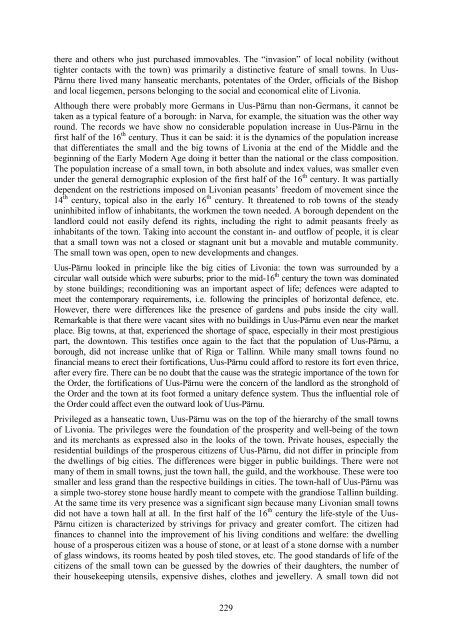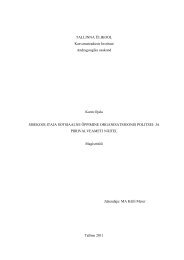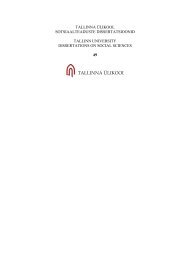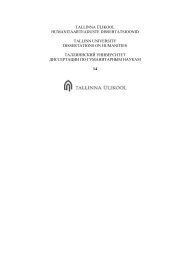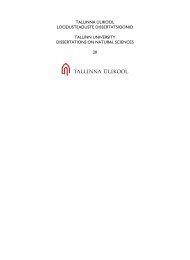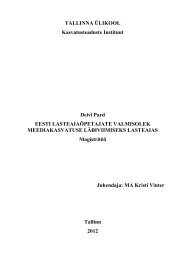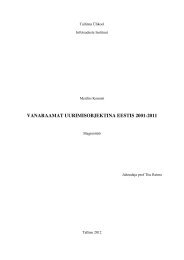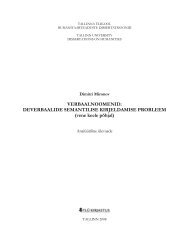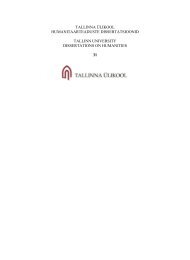Create successful ePaper yourself
Turn your PDF publications into a flip-book with our unique Google optimized e-Paper software.
there and others who just purchased immovables. The “invasion” of local nobility (withouttighter contacts with the town) was primarily a distinctive feature of small towns. In Uus-Pärnu there lived many hanseatic merchants, potentates of the Order, officials of the Bishopand local liegemen, persons belonging to the social and economical elite of Livonia.Although there were probably more Germans in Uus-Pärnu than non-Germans, it cannot betaken as a typical feature of a borough: in Narva, for example, the situation was the other wayround. The records we have show no considerable population increase in Uus-Pärnu in thefirst half of the 16 th century. Thus it can be said: it is the dynamics of the population increasethat differentiates the small and the big towns of Livonia at the end of the Middle and thebeginning of the Early Modern Age doing it better than the national or the class composition.The population increase of a small town, in both absolute and index values, was smaller evenunder the general demographic explosion of the first half of the 16 th century. It was partiallydependent on the restrictions imposed on Livonian peasants’ freedom of movement since the14 th century, topical also in the early 16 th century. It threatened to rob towns of the steadyuninhibited inflow of inhabitants, the workmen the town needed. A borough dependent on thelandlord could not easily defend its rights, including the right to admit peasants freely asinhabitants of the town. Taking into account the constant in- and outflow of people, it is clearthat a small town was not a closed or stagnant unit but a movable and mutable community.The small town was open, open to new developments and changes.Uus-Pärnu looked in principle like the big cities of Livonia: the town was surrounded by acircular wall outside which were suburbs; prior to the mid-16 th century the town was dominatedby stone buildings; reconditioning was an important aspect of life; defences were adapted tomeet the contemporary requirements, i.e. following the principles of horizontal defence, etc.However, there were differences like the presence of gardens and pubs inside the city wall.Remarkable is that there were vacant sites with no buildings in Uus-Pärnu even near the marketplace. Big towns, at that, experienced the shortage of space, especially in their most prestigiouspart, the downtown. This testifies once again to the fact that the population of Uus-Pärnu, aborough, did not increase unlike that of Riga or Tallinn. While many small towns found nofinancial means to erect their fortifications, Uus-Pärnu could afford to restore its fort even thrice,after every fire. There can be no doubt that the cause was the strategic importance of the town forthe Order, the fortifications of Uus-Pärnu were the concern of the landlord as the stronghold ofthe Order and the town at its foot formed a unitary defence system. Thus the influential role ofthe Order could affect even the outward look of Uus-Pärnu.Privileged as a hanseatic town, Uus-Pärnu was on the top of the hierarchy of the small townsof Livonia. The privileges were the foundation of the prosperity and well-being of the townand its merchants as expressed also in the looks of the town. Private houses, especially theresidential buildings of the prosperous citizens of Uus-Pärnu, did not differ in principle fromthe dwellings of big cities. The differences were bigger in public buildings. There were notmany of them in small towns, just the town hall, the guild, and the workhouse. These were toosmaller and less grand than the respective buildings in cities. The town-hall of Uus-Pärnu wasa simple two-storey stone house hardly meant to compete with the grandiose Tallinn building.At the same time its very presence was a significant sign because many Livonian small townsdid not have a town hall at all. In the first half of the 16 th century the life-style of the Uus-Pärnu citizen is characterized by strivings for privacy and greater comfort. The citizen hadfinances to channel into the improvement of his living conditions and welfare: the dwellinghouse of a prosperous citizen was a house of stone, or at least of a stone dornse with a numberof glass windows, its rooms heated by posh tiled stoves, etc. The good standards of life of thecitizens of the small town can be guessed by the dowries of their daughters, the number oftheir housekeeping utensils, expensive dishes, clothes and jewellery. A small town did not229


